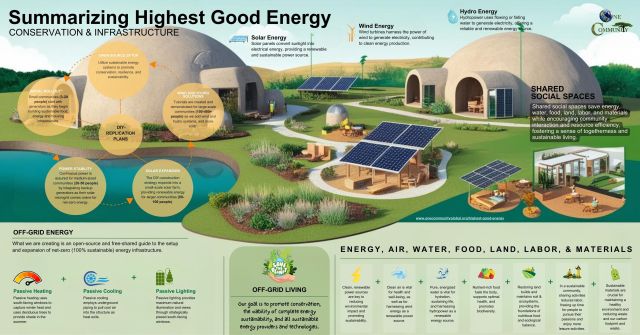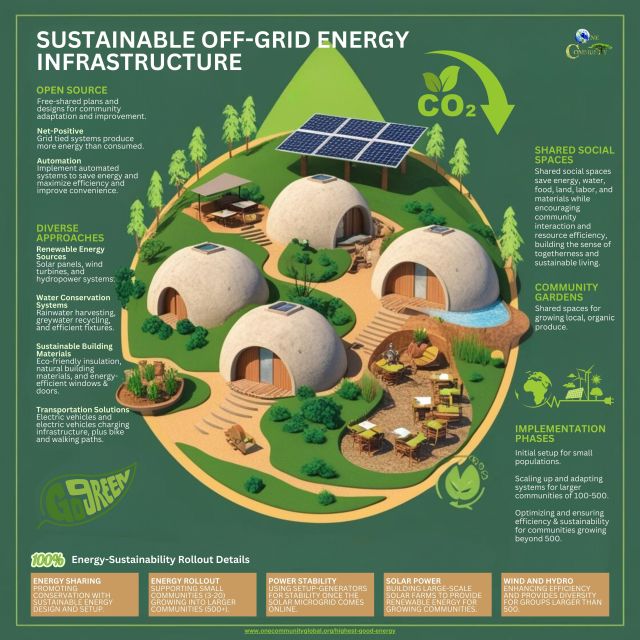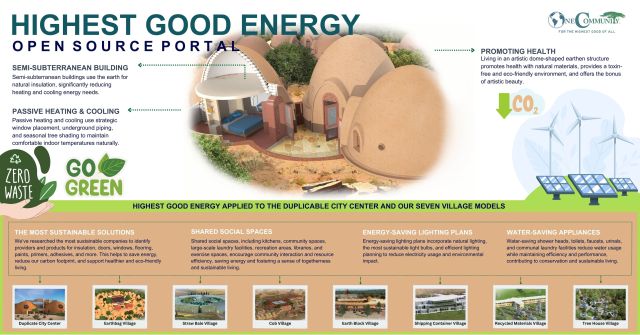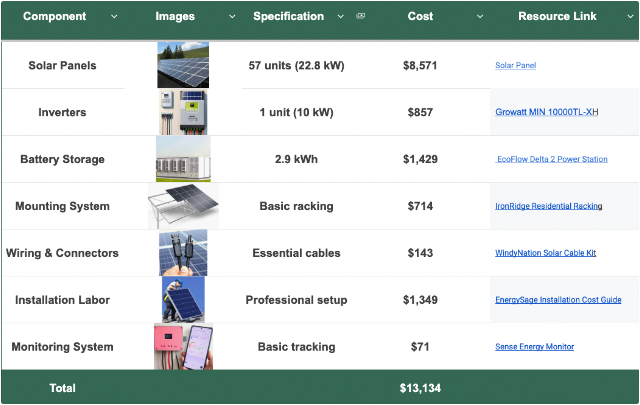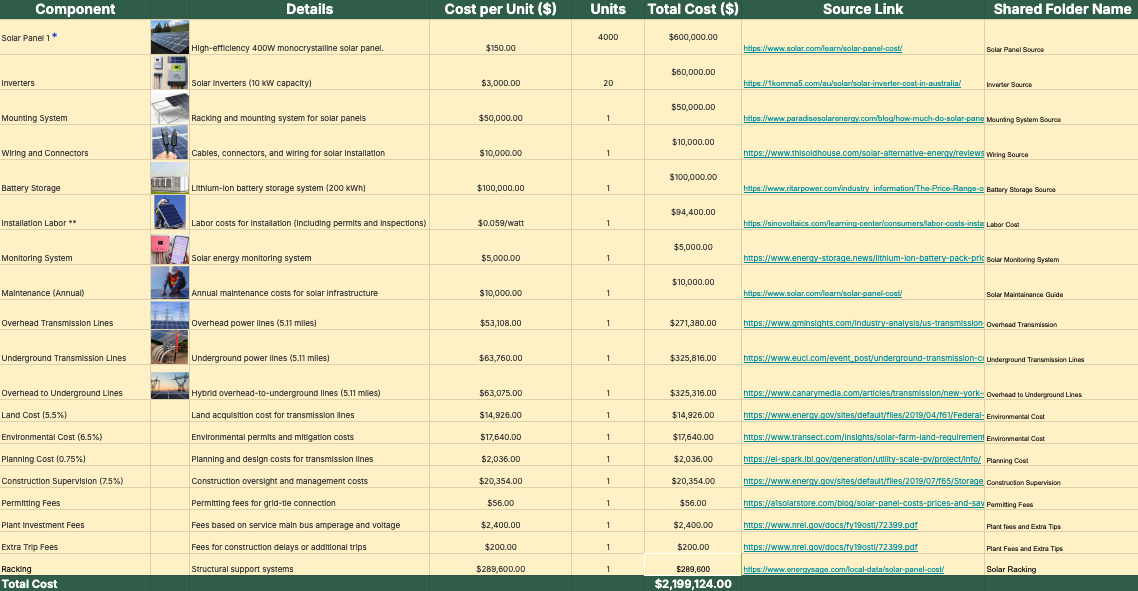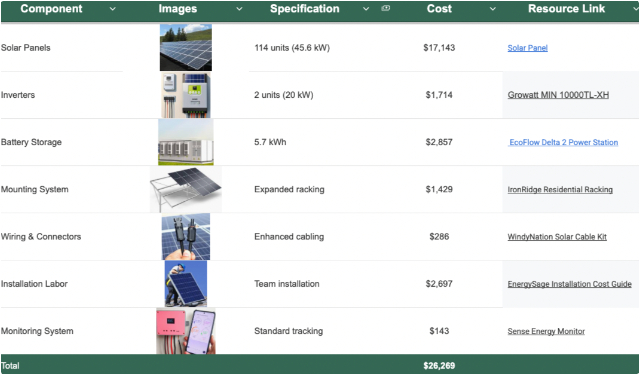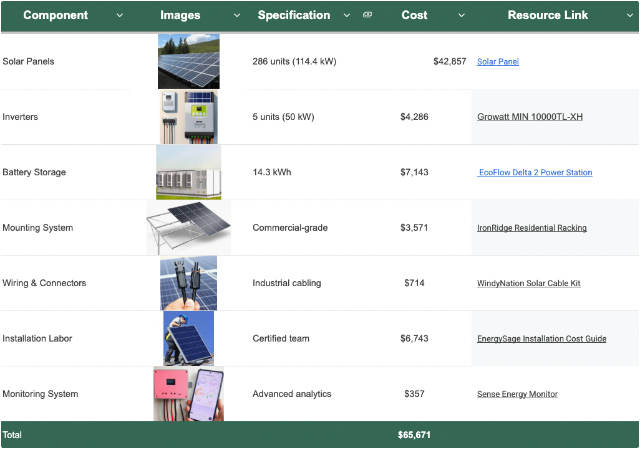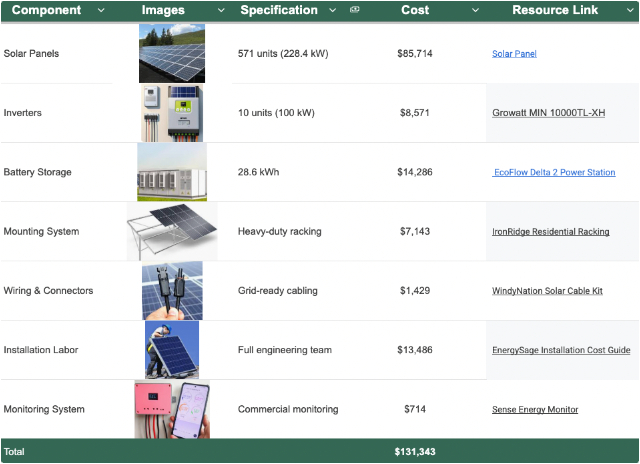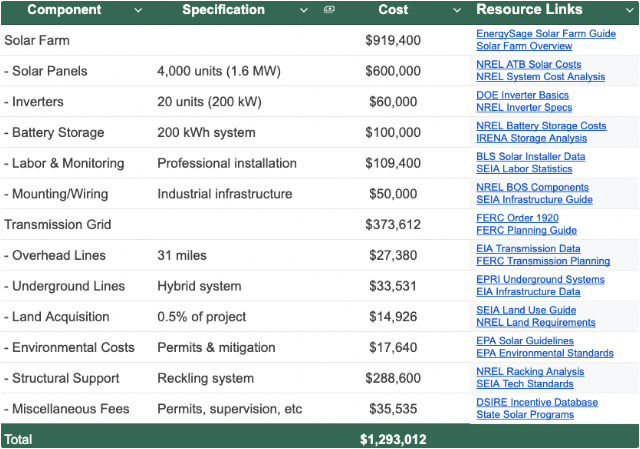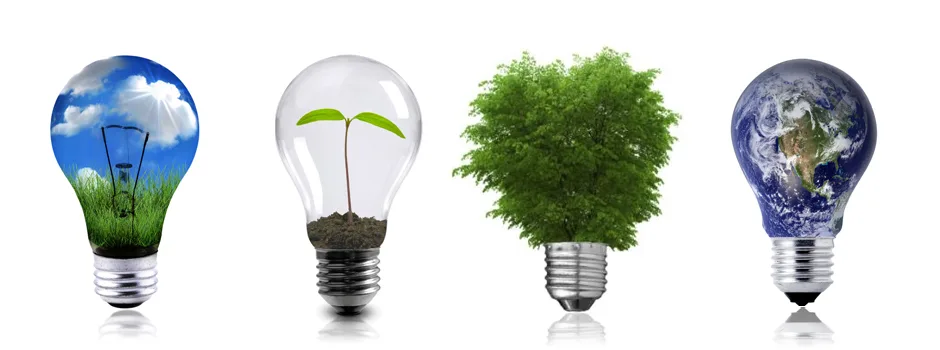
Highest Good Energy: Conservation & Infrastructure
Energy infrastructure and conservation methods are foundational to the creation of self-sufficient and self-propagating teacher/demonstration communities, villages, and cities to be built around the world. This page is an open source and free-shared guide to the setup and expansion of net-zero (100% sustainable) energy infrastructure during the construction of teacher/demonstration hub food infrastructure, village models, the Duplicable City Center, and beyond. Once on the property, we will further evolve the Highest Good energy® foundations and open source resources with additional implementation and research results of an even broader diversity of energy-saving strategies and alternative energy infrastructure methodologies.
This page contains the following sections related to Highest Good Energy:
- What is Highest Good Energy
- Why Highest Good Energy
- Ways to Contribute
- The Highest Good Energy Open Source Portal (Collaborative resource and information hub)
- 100% Energy-Sustainability Rollout Details
- Off-grid Energy Implementation Details for 3-10 People
- Off-grid Energy Implementation Details for 10-20 People
- Off-grid Energy Implementation Details for 20-50 People
- Off-grid Energy Implementation Details for 50-100 People
- Off-grid Energy Implementation Details for 100-400 People
- Off-grid Energy Implementation Details for 400+ People
- Resources
- Summary
- FAQ
- Consultants for this component of One Community
HIGHEST GOOD ENERGY SEARCH ENGINE
WHAT IS HIGHEST GOOD ENERGY®
 One Community defines Highest Good energy as renewable and conscientious of the air, water, and land that we all share. It is also an active approach to energy saving strategies that we are implementing including semi-subterranean building, shared social spaces, passive heating, cooling, and lighting, maximally efficient hot water heating, water saving shower heads, energy saving lighting plans, and more. One Community’s Highest Good energy rollout is detailed below assuming zero initial energy infrastructure and starting with traditional generators, grid tying, and then building a comprehensive solar micro-grid capable of producing sufficient energy surplus in the summer to equal or surpass our supplemental energy purchased in the winter. This will make our energy production sustainably net-zero or net-positive.
One Community defines Highest Good energy as renewable and conscientious of the air, water, and land that we all share. It is also an active approach to energy saving strategies that we are implementing including semi-subterranean building, shared social spaces, passive heating, cooling, and lighting, maximally efficient hot water heating, water saving shower heads, energy saving lighting plans, and more. One Community’s Highest Good energy rollout is detailed below assuming zero initial energy infrastructure and starting with traditional generators, grid tying, and then building a comprehensive solar micro-grid capable of producing sufficient energy surplus in the summer to equal or surpass our supplemental energy purchased in the winter. This will make our energy production sustainably net-zero or net-positive.
From there we will continue to develop and implement additional energy-saving strategies while we expand the energy infrastructure with more solar, wind, hydro, and/or any newer technologies that become available and can be determined to be superior to other alternatives.
WHY HIGHEST GOOD ENERGY®
 The current global approach to energy is not sustainable. One Community sees open source sharing 100% sustainable/net-zero energy setup and expansion as part of the solution. We are doing this as energy infrastructure for newly-beginning teacher/demonstration hubs through well-established hubs of 400+ people. Our goal is to promote conservation, all sustainable energy providers and technologies, and the viability of complete energy sustainability. We see making small-to-large group energy self-sufficiency easier, more affordable, and more attractive as part of our comprehensive approach to evolving sustainability that will positively and permanently transform the world for everyone.
The current global approach to energy is not sustainable. One Community sees open source sharing 100% sustainable/net-zero energy setup and expansion as part of the solution. We are doing this as energy infrastructure for newly-beginning teacher/demonstration hubs through well-established hubs of 400+ people. Our goal is to promote conservation, all sustainable energy providers and technologies, and the viability of complete energy sustainability. We see making small-to-large group energy self-sufficiency easier, more affordable, and more attractive as part of our comprehensive approach to evolving sustainability that will positively and permanently transform the world for everyone.
WAYS TO CONTRIBUTE TO EVOLVING THIS SUSTAINABILITY COMPONENT WITH US
SUGGESTIONS | CONSULTING | MEMBERSHIP | OTHER OPTIONS
HIGHEST GOOD ENERGY® OPEN SOURCE PORTAL
We are beginning with open source and free-sharing comprehensive strategies for energy setup and conservation through semi-subterranean building, shared social spaces, passive heating, cooling, and lighting, maximally efficient hot water heating, water saving shower heads, energy saving lighting plans, and the detailed energy infrastructure rollout and establishment plan outlined on this page. As we complete them, the open source resources list below will continue to expand with tools, tutorials, and DIY resources for duplication of all aspects of One Community’s energy infrastructure:
ENERGY INFRASTRUCTURE IMPLEMENTATION DETAILS
 Before One Community (or any off-grid teacher/demonstration community, village, or city) can begin construction of its primary structures, an initial team will need to move to the property to survey the land and begin food infrastructure preparation, finalize development plans, and create the “pre-infrastructure” that needs to exist to support the construction of the first phase of the One Community infrastructure. This group will need access to electrical power before much else can be done and we’ve determined that temporary mobile diesel generators are the best choice for this initial power. From that point forward, more extensive and permanent infrastructure will be built including a connection to the grid, battery storage, and solar and wind as the primary power sources. The generators will then serve as standby emergency backup supply.
Before One Community (or any off-grid teacher/demonstration community, village, or city) can begin construction of its primary structures, an initial team will need to move to the property to survey the land and begin food infrastructure preparation, finalize development plans, and create the “pre-infrastructure” that needs to exist to support the construction of the first phase of the One Community infrastructure. This group will need access to electrical power before much else can be done and we’ve determined that temporary mobile diesel generators are the best choice for this initial power. From that point forward, more extensive and permanent infrastructure will be built including a connection to the grid, battery storage, and solar and wind as the primary power sources. The generators will then serve as standby emergency backup supply.
What follows is the specific plan for this energy rollout starting with the initial survey team of 10-20 people through our first 400. As part of our open source goals, this rollout is designed and described in detail to help those interested in duplication. Additional details will be added as we complete them. We discuss the complete energy infrastructure implementation plan with the following sections:
- Off-grid Energy Implementation Details for 3-10 People
- Off-grid Energy Implementation Details for 10-20 People
- Off-grid Energy Implementation Details for 20-50 People
- Off-grid Energy Implementation Details for 50-100 People
- Off-grid Energy Implementation Details for 100-400 People
- Off-grid Energy Implementation Details for 400+ People
PHASE 1: INITIAL SURVEY TEAM: ENERGY FOR 3-10 PEOPLE
 The Initial Survey Team moving onto the property will use existing energy infrastructure and start establishing relationships with zoning and planning people. They will begin discussion with county for grid tie, order the generators and battery storage system, propose locations for solar and wind, and check in with Permaculture Design ethics and principles and the related list of questions.
The Initial Survey Team moving onto the property will use existing energy infrastructure and start establishing relationships with zoning and planning people. They will begin discussion with county for grid tie, order the generators and battery storage system, propose locations for solar and wind, and check in with Permaculture Design ethics and principles and the related list of questions.
Solar energy equipment cost for 3 – 10 people, including panels, inverter, battery, and racking:
PHASE 2: LANDING PARTY: ENERGY FOR 10-20 PEOPLE
 The primary focus for the Landing Party moving onto the property must be providing electricity as quickly as possible. There is also a need for flexibility of the generated power in order to provide the group with access wherever we need it. This will be accomplished initially with two 100 kW diesel generators and a battery energy storage system. Installation of the Solar Microgrid will begin in the second month, as part of the next phase.
The primary focus for the Landing Party moving onto the property must be providing electricity as quickly as possible. There is also a need for flexibility of the generated power in order to provide the group with access wherever we need it. This will be accomplished initially with two 100 kW diesel generators and a battery energy storage system. Installation of the Solar Microgrid will begin in the second month, as part of the next phase.
At the completion of the initial rollout, the diesel generators will be used as emergency backup power for just the Duplicable City Center in case of a catastrophic situation. In a situation like this, people would go to the City Center where the diesel generators would generate power for the essential systems like the kitchen.
Here is the cost analysis* for this phase:

10-20 Person Energy Rollout Equipment Costs – Click for most current spreadsheet that includes links
* Cost as of 07/25
Here is the research we did to select the best diesel generators:
Note: Eventually the generators will either be mounted permanently on slabs or just serve as mobile sources of construction power when required. As more permanent sources of electricity (grid connection, solar, wind) and storage are set-up, these generators will be disconnected to serve as backup for critical systems in case of a grid-tie emergency like a cut power line. At some point we hope to phase them out completely.
Detailed cost breakdown of a solar infrastructure project, covering equipment, installation, transmission, and permitting:
The action items for this stage of the energy infrastructure rollout are as follows: (click here for details on all component rollout phases)
- Purchase and implement generators, battery bank, and fuel storage
- Complete everything needed for grid connection in the next phase
- Establish the Transition Kitchen, temporary showers, temporary housing, and foundations for Phase I hydronics implementation
- Outline the locations and confirm the energy needs for the Earthbag Village, Duplicable City Center, food infrastructure, and Ultimate Classroom
10-20 PEOPLE POWER-IMPLEMENTATION DETAILS
In the beginning, the objective is to satisfy the energy needs of the initial construction camp, transition kitchen, and food self-sufficiency plan while beginning construction of the Earthbag Village, Duplicable City Center, food infrastructure, and Ultimate Classroom. The generators are sized for these requirements.
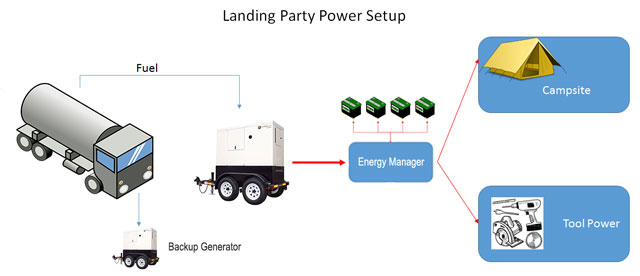
Landing Party Power Setup Overview

Mobile Diesel Generator
The reasoning behind having two 100 kW generators first is that they will provide intermittent and mobile power for use on miscellaneous work sites throughout the property. As part of generator add-ons, a sound enclosure and a 250-gallon sub-base fuel tank is attached to both generators to provide enough fuel for about 3 days. This is because the per-day fuel use for the landing party is estimated to be about 69 gallons, as explained in the following sections. Generator 1, to enable mobility, must be attached with a double-axle trailer which can be towed as a mobile generator unit to miscellaneous work sites. Generator 2 acts as a stationary backup supply and the battery pack acts as the stationary active supply. Extra fuel would be stored in a fuel bladder with a 2000 gallon capacity, enough for up to 28 days, after which it would need to be refilled from the closest gas station.
To appropriately size these generators, the complete power needs for the “Landing Party” have been analyzed. The total power and energy use at this stage is covered in detail in this spreadsheet. It includes the following key areas:
- Large Construction Equipment: The process of composting, based on the soil amendment plan, involves the use of a shredder to crush larger materials into smaller individual particles. Also, construction during this stage will require cement, produced by using cement mixers.
- Washers and Dryers: These will be the same ones used as part of the eco-laundry rollout. ENERGY STAR washers and dryers with lower water and energy needs are selected there, which when simultaneously operated, also add to the peak power requirement.
- Transition Kitchen equipment: The energy needs of the kitchen equipment (refrigerator, electric countertop griddle, etc.), as mentioned in the transition kitchen cost analysis, are calculated here.
- Heat: The most efficient option to heat a party of 20 people in temporary structures would be to use a “heat the person and not the room” approach with individual electric dish heaters and electric blankets.
- Computers, mobile phones, and other appliances: For this stage, there will be a lot of designing, planning, and open source sharing carried out on computers. We estimate the energy needs as: 10 desktops = 1.75 kW, 10 Laptops = 0.75 kW. Total = 2.5 kW. Mobile phone energy requirements are negligible.
- Heating and Pumping Water: The diesel generator system must have the capacity to power heat groundwater pumped from the wells to the instantaneous water heaters and pumps of the hydronics system. Pumps will also be required to transport this water to the desired locations. The property already has a pump which we calculated to be sufficient for 10-20 people. The energy requirement would then simply be powering the instantaneous water heaters for bathing in temporary shower structures and cooking needs. One of the water heaters can simultaneously heat water for up to four showers and a sink. At this stage, a total of two of these would meet all needs involving cooking and bathing. These water heaters will later be repurposed into use in the eco-shower structures of the Earthbag Village.
- Tools and Chargers for Construction: This stage will involve a lot of construction work at multiple sites, which would involve the use of various power tools. The following will meet our needs: Seven rechargeable combo kits including a Drill, Reciprocating Saw, Impact Driver, Circular Saw, and Grinder plus 5 additional Jig Saws and 3 additional Table Saws. These would include 30 Ô 2 Ah Lithium Ion batteries, which could be interchangeably used with different tools. At any given time, the maximum charging load is assumed to be 15 batteries.
- Lighting: Lighting needs for this stage would involve illuminating the transition kitchen, temporary sleep shelter, community nighttime workspace, and the Ultimate Classroom structure.
The peak power load is identified to be during the evening at 171.8 kW (click for spreadsheet). Accounting for additional needs, and considering that this generator system will later serve as an emergency backup for the Earthbag Village (Pod 1) and Duplicable City Center, we multiply by a safety factor of 1.15 to arrive at a final estimated required capacity of 200 kW.
For easy fuel storage, a trailer would provide mobility for frequent refueling at a biodiesel fueling station or delivery service. For more permanent storage a bladder might be the best and lowest-cost solution.
Note: Fuel consumption per generated kW varies with electrical load when using a generator. The chart below shows average fuel consumption in relation to % output (load). Since this chart is for a 100 kW unit, the % load is equal to the kilowatt output (50% = 50 kW).

100 kW Generator Power Efficiency and Consumption Projections
WHY INCLUDE A BATTERY STORAGE SYSTEM
A look at the bi-hourly energy breakdown shows that the second generator’s capacity is not used optimally, since it sits idle over most of the day. Also, since the generator does not operate at full load most of the time, a loss of efficiency takes place, which increases the fuel costs significantly. This also supports the rationale for 2 smaller generators versus 1 large, because just using 1 large generator would mean even more frequent use of that one generator at less than 100% efficiency. Looking at the bottom of the energy use breakdown spreadsheet, you can see that the efficiency of 2 generators working as needed to supply power provides a 35-cents per kWh yield, compared to regular household electricity costs of ~0.12 cents per kWh.
An alternative, efficient, and environmentally conscious way to satisfy the energy needs would be to use a battery energy storage system along with an energy management system. Such a system would ideally run the generator at 100% capacity for a particular number of hours, which would be divided between powering the daily needs and charging the battery. During times of the day when the battery storage is enough to power all needs, the generator could be turned off and the battery could be discharged. Another important note is that the power needs of the camp, at this stage, would be fluctuating as the various tools and appliances are plugged into and out of the system. Batteries, as a flexible power source, are better suited to serve these demand intermittencies compared to direct generator supply.
A forecast, such as the one demonstrated in the energy use breakdown spreadsheet, can be generated by the energy management system every day to anticipate the energy needs of the camp and plan the optimum sources for providing power at all times.
Looking again at the bottom of the energy use breakdown, you can see that this addition of batteries and the added ability to run a single generator for all power needs (with the second generator now only needed for backup) provides a 22.6 cents per kWh yield, compared to 35 cents per kWh yield with generators running to supply power as needed, and regular household electricity costs of ~0.12 cents per kWh. These savings guided our decision to add in batteries.
Also, once the solar microgrid and wind infrastructure are set up, a battery energy storage system will become a necessity. Since the storage system is modular, it can be repurposed as per the requirements of the rest of this energy infrastructure rollout. This approach is further supported by the reality that the cost of battery energy storage systems continues to drop with increasing research and development in the field.
All this said, the ideal energy infrastructure at this stage would therefore include:
- Generator 1: 100 kW – Active
- Generator 2: 100 kW – Standby for emergencies
- Battery Storage System: 200 kWh – Active (estimated based on the maximum energy use during all times of the day)
As previously stated, all of this infrastructure will also transfer over for backup use (generators) and integrated use (batteries) as we’re completing construction of the Duplicable City Center and Earthbag Village.
Solar energy equipment cost for 10–20 people, including panels, inverter, battery, and racking:
PHASE 3: POWER FOR 20-50 PEOPLE
 The rest of the Pioneer Team will move onto the property after the “landing party” has completed their site survey, identified the locations of all planned construction, begun working on the infrastructure, and completed and gained approval for all the initial building plans. At this point, grid connection will need to be established for power supply to support construction as well as operation of a large-scale sustainable water heating system and other systems which will be coming online. Also, enough planning will have been done to begin working on the long-term energy infrastructure while still allowing for flexible power generation for construction needs. This means beginning to build the solar microgrid that will service the Duplicable City Center and Earthbag Village (Pod 1).
The rest of the Pioneer Team will move onto the property after the “landing party” has completed their site survey, identified the locations of all planned construction, begun working on the infrastructure, and completed and gained approval for all the initial building plans. At this point, grid connection will need to be established for power supply to support construction as well as operation of a large-scale sustainable water heating system and other systems which will be coming online. Also, enough planning will have been done to begin working on the long-term energy infrastructure while still allowing for flexible power generation for construction needs. This means beginning to build the solar microgrid that will service the Duplicable City Center and Earthbag Village (Pod 1).
The action items for this stage of the energy infrastructure rollout are as follows:
- Establish grid connection
- Construct and bring the solar micro-grid online
- Construct and bring the two net-zero bathrooms and first two communal eco-showers online
- Use the generators as backup systems and to provide mobile power to remote construction sites
- Expand the battery storage system to react to demand-response programs and also take advantage of time-of-use electricity pricing
- Bring the first stage of the hydronic systems online using a hot water tank, heat pump, and additional instantaneous water heaters. Also order equipment for the large-scale phase of hydronic systems implementation that will happen with the Third Team of 50-100 People
Note: Check THIS PAGE for a tutorial on 100% off-grid energy infrastructure.
20-50 PEOPLE POWER-IMPLEMENTATION DETAILS
Power production at this phase of construction will include implementation of the complete energy infrastructure needed for powering the Duplicable City Center and Earthbag Village (Pod 1). The portable generator and batteries will be used for tool and other remote power needs (and main-site needs) until grid connection is established and operating as the primary power supply. During this time, the solar micro-grid will also be installed and brought online.
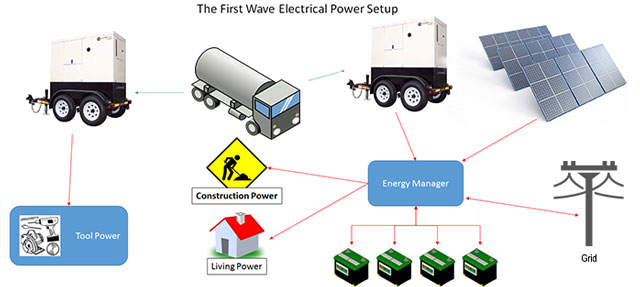
Second Team Power Setup Overview
The core of the Duplicable City Center and Earthbag Village (Pod 1) power systems will look like this:

Net-zero Energy Foundations
First we will connect the grid supply and additional battery banks to the Energy Management System. We will then begin our transition to solar power by connecting the solar micro-grid to the system as quickly as possible to decrease use of the grid power and phase out the diesel generators.
Note: The battery bank does not need to be full-size yet, but must have the capability of increasing to that size in the future.
In order to size our solar array, and estimate the additional battery bank sizing and daily cost of electricity to operate, we estimated the power and energy needs for this first team. The foundational data and estimates used for sizing are the same as that of the 10-20 initial survey team, but scaled up appropriately. Here’s what this looks like:

Power Needs Calculations and Comparisons for 10-20 and 20-50 People – Click for the open source spreadsheet with the most current data
ADDITIONAL POWER NEEDS FOR THIS 20-50 PERSON TEAM
There will be additional power needs once the second group of 20-50 people arrive. They are included in the spreadsheet above and consist of the following areas:
- Water: As the number of people increases to 50 with this first team, as many as 4 additional instantaneous water heaters will be needed to heat water for bathing in the communal eco-showers. The second stage of the hydronics implementation now involves bringing a hot water tank and heat pump online too, and preparing for the next team by laying down piping and ordering components required for construction of the large-scale hydronics components.
- Lighting, Heating, Washers and Dryers, and Computers: For the purpose of an estimation, all these energy requirements will increase almost linearly with the additional number of people joining the team on the property. To account for these changes we took the initial survey team’s requirements as a base and scaled it to satisfy the living requirements of 50 people. Lighting will increase as the temporary sleeping camp increases in size, as will the number of computers, dish heaters, and electric blankets. The number of washers and dryers will remain the same but with more frequent loads for more people, thus increasing our energy needs almost linearly to account for the additional 30 people.
- Large Equipment and Tools: To support the heavy construction at this stage, the number of cement mixers and tools should triple compared to the previous stage. Construction for the Duplicable City Center and Earthbag Village (with the central Tropical Atrium) will start during this stage. These additional power requirements are factored in while estimating the daily operating costs.
- Transition Kitchen Equipment: The transition kitchen equipment is designed to support cooking for up to 50 people. The energy needs for this section would thus remain the same as the previous stage. Construction of the Duplicable City Center kitchen will begin during this stage though, and be complete before beginning the 50-100 person team.
- Net-zero Bathrooms and Communal Shower Structures: During this stage, the two net-zero bathrooms and first two communal eco-showers will come online. Water heating will be provided by a combination of a heat pump, hot water tank, heat exchanger, and instantaneous water heaters. Also, some power will be required to enable flushing in the net-zero bathrooms, which is calculated and accounted for.
Looking at these increased power requirements for the 20-50 person team, you will notice that the energy infrastructure must be more than doubled to supply enough electricity and continue construction. This is why it makes economic sense at this stage to plan for the longer term and onwards by connecting to the grid. This will assure reliable connectivity all day long during this transition to a permanent, large-scale, and sustainable solar micro-grid energy infrastructure foundation.
Solar energy equipment cost for 20–50 people, including panels, inverter, battery, and racking:
PHASE 4: POWER FOR 50-100 PEOPLE
 By now, construction of the initial components of One Community are in full swing and we’re ready to bring on additional team members to accelerate the pace of progress. Along with population increases we will see the demand for electrical power and hot water increase. For instance, the Duplicable City Center kitchen and large-scale laundry facility will both become fully operational during this time and draw considerable electric power. Other structures coming online during this phase are two more Communal Eco-showers and both Vermiculture Eco-toilets. As the demand grows, we shall be taking advantage of the energy efficiencies that are associated with larger systems and implement additional energy reduction and conservation measures too.
By now, construction of the initial components of One Community are in full swing and we’re ready to bring on additional team members to accelerate the pace of progress. Along with population increases we will see the demand for electrical power and hot water increase. For instance, the Duplicable City Center kitchen and large-scale laundry facility will both become fully operational during this time and draw considerable electric power. Other structures coming online during this phase are two more Communal Eco-showers and both Vermiculture Eco-toilets. As the demand grows, we shall be taking advantage of the energy efficiencies that are associated with larger systems and implement additional energy reduction and conservation measures too.
The action items for this stage of the energy infrastructure rollout are as follows:
- Start expanding the solar capabilities of the property
- Experiment to identify best practices for our solar/electrical conversion
- Start developing the wind microgrid and large-scale and longer-term energy storage options
- Full implementation of the hydronic systems, Duplicable City Center, and Earthbag Village
- Find a permanent position for the two generators. We’ll be foregoing mobility, but we’ll need all the generators and battery packs ready for backup supply during this time of significant energy usage
Related to the last bullet-point above, here are the viability projections for energy storage starting with small amounts of energy being stored for less than a day and progressing to megawatts being stored for a year or more. The red line is our power demand and what you see is that with storage capacity there is an amount of stored energy that can offset cost in the different mediums: batteries, compressed storage, etc. If we need to store power for 1 month, batteries are not a viable solution, but hydrogen storage would be once energy storage needs are sufficient to warrant the added expense of creating infrastructure like this.

Different Energy Storage Solutions
Solar energy equipment cost for 50–100 people, including panels, inverter, battery, and racking:
50-100 PEOPLE POWER-IMPLEMENTATION DETAILS
This construction period will be very energy-intensive and will require large amounts of power. As development continues, the hydronic systems become operational and the total load on the Energy Manager will increase. As energy-saving measures are added, the load will decrease. Overall though, our total demand for power, both hydronic and electrical, will increase. The Duplicable City Center radiant heating will be the largest consumer of power (both hydronic and electric). Therefore, it will be beneficial to have the core energy systems (all solar arrays, full-size battery storage, and grid connection) and some of the energy-reducing measures in place before the hydronic system is enabled. Further evaluation on the property will dictate the best size and placement of the wind microgrid.
Estimation of energy requirements for the construction and operation of the next set of structures, as well as the lifestyle for the increased number of people was done to account for daily operational costs.

Power and Energy Needs Analysis for 20-50 and 50-100 – Click for the spreadsheet with the most current data
The lighting, construction, computing loads can simply be doubled relative to the previous team. With the eco-laundry coming online, 5 additional machines each for washing and drying, will be brought in which would increase the load due to laundry. Another major increase in energy use at this stage is the switch from the transition kitchen (which will now serve as a mobile kitchen for remote construction) to the Duplicable City Center kitchen. Both the eco-laundry and kitchen will be built on the foundational structure of Duplicable City Center, which would be ready by now.
Heating of this structure would be supported through electric boilers, facilitating radiant floor heating as per the hydronic systems plan. At this stage, some of the instantaneous water heaters may be used to provide point-of-use hot water at remote construction sites and the transition kitchen, and at the communal eco-showers. After adding 6 additional water heaters for this stage, the rest of these shall provide hot water for all daily needs at the Duplicable City Center and surrounding structures. The sustainable water heating page describes this entire system in greater detail. Energy-conserving measures like solar heat collectors and additional heat exchangers shall come online to improve the overall efficiency of this larger system.
Additionally, we will be bringing online the Wet Lab for the Earthbag Village Greywater recycling system. This will allow for safe processing and cleaning of greywater and reusing it for flushing toilets and agricultural purposes. Power needed for the lab equipment is also accounted for in the process of estimating total requirements of the energy infrastructure for this phase.
PHASE 5: THE FIRST FIVE YEARS – POWER FOR 100-400 PEOPLE
 Throughout the first five years on the property, One Community will construct several key structures. These will include the Duplicable City Center, the Earthbag Village (Pod 1), Straw Bale Village (Pod 2), food greenhouses, and additional village models if possible. The expectation from residents working in these areas and visitors touring our community will be that the solutions we are testing and displaying are genuine and practical solutions. During this time the Phase I energy system (described above) will be completely developed and the new focus will be testing and monitoring this system, fine tuning and conservation strategies, and planning and implementation of next steps.
Throughout the first five years on the property, One Community will construct several key structures. These will include the Duplicable City Center, the Earthbag Village (Pod 1), Straw Bale Village (Pod 2), food greenhouses, and additional village models if possible. The expectation from residents working in these areas and visitors touring our community will be that the solutions we are testing and displaying are genuine and practical solutions. During this time the Phase I energy system (described above) will be completely developed and the new focus will be testing and monitoring this system, fine tuning and conservation strategies, and planning and implementation of next steps.
The action items for this stage of the energy infrastructure rollout are as follows:
- Fine tune existing systems to maximize efficiency
- Complete construction of the Duplicable City Center, the Earthbag Village (Pod 1), Straw Bale Village (Pod 2), and food greenhouses
- Determine and implement the next phase of the energy infrastructure development needed to support the remaining village models and our open source global transformation strategy
100-400 PEOPLE POWER-IMPLEMENTATION DETAILS
As the entire Duplicable City Center structure comes online, the efficiency of radiant floor heating will only increase as the number of people reaping its benefits increase. The number of boilers that come online will be increased to full capacity in order to ensure enough hot water for the hydronic system. The communal eco-showers will still derive their hot water needs from instantaneous water heaters.
The transition kitchen, construction equipment, and power tools will draw power at remote locations through batteries, solar power, or backup generators. The Earthbag Village and Straw Bale Village will be phased in as their construction completes and then construction of the additional village models will begin. Lighting and other energy needs of these structures will be scaled up as required based on previous estimates.
All remaining food infrastructure structures including the aquapinis, walipinis, hoop houses, and other aspects of the large-scale gardening will also need power for daily operation. Lighting, heating, and irrigation constitute the major energy consuming aspects for all food infrastructure. Lighting needs can be determined from this link, or estimated based on calculations for previous structures. Power drawn by irrigation systems, once set-up, will be negligible since the required water pressure would be standard. The heating and cooling of Aquapini and Walipinis is facilitated by the use of climate batteries.
This phase of development will be about monitoring all electrical energy being consumed and making expansion decisions based on needs and what we learn. The monitoring will be accomplished through meters for all individual living spaces and ammeters on any main power lines that would output the amps being used at that instant (see the Control Systems page for details). Since the voltage will be known, the power will then be a simple calculation done by either a designed system or one bought off the shelf. That power (in Watts or kW) will then be logged over time to get the amount of energy in kWh used during the course of the day.
The following picture illustrates this with each “A” representing a monitoring point that communicates with a power display feeding data to a central data analysis point:
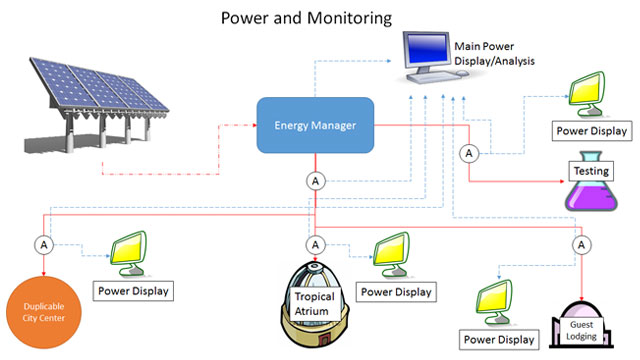
Monitoring Electrical Energy Used by 100-400 People
Electrical Power Monitoring will have displays at the source and connections to a main power display that will monitor and control the electrical energy management sub-system.
Similarly, hot water used in showers, for domestic use, and the hydronic systems can be monitored by knowing the flow rate, temperature, and amount of time used. With instantaneous water heaters at points of service, the electrical energy draw from those units could also be used with the addition of the known hot-tank water temp and the flow rate of the use.
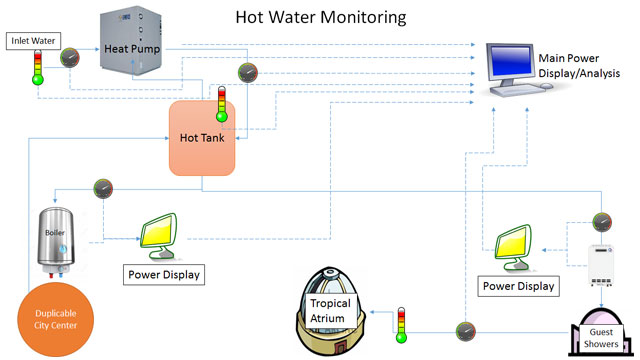
Hot Water Monitoring and Data Analysis
In short, hot water monitoring needs two pieces of data for each point: temperature and flow. For showers and the boiler, temperature can be replaced by an electrical power reading which will already be monitored by the electrical energy monitoring software and relayed to the Main Power Display. For everything else, temperature and flow monitors will do the job.
Specifically monitoring all of these things will allow us to fine tune our consumption patterns and open source share our results. Tracking these metrics for guests will also be a major benefit to the mission of One Community by giving the constant flow of temporary residents/visitors access to accurate (and anonymous) reports of their energy usage during their stay. In so doing, we help to educate people and give them the opportunity to become more conscientious about their use.
This will also create ultra-accurate energy needs assessments to help us with our planning and construction of each additional open source village needed for expansion to host people beyond the initial 400.
Solar energy equipment cost for 100–400 people, including panels, inverter, battery, and racking:
THE LONG TERM: POWER FOR 400+ PEOPLE
Sustainable energy, and renewable energy abundance, is all about careful planning and system redundancy. We won’t be able to effectively plan our power needs beyond the Earthbag Village (Pod 1), Duplicable City Center, and Straw Bale Village (Pod 2) until all three of these components of our infrastructure are complete and we’ve gained the experience of using the systems designed above. While it is predictable that we will actually increase our energy efficiency over time due to increased conservation methods and “fine tuning” of our usage patterns, it is also predictable that we will have energy needs we haven’t accounted for.
Learning from experience, learning more about our specific property and how effective options like wind power may be, possible implementation of new energy technologies, and a better understanding of our specific needs will all be crucial to planning our power infrastructure for the other open source villages and beyond.
RESOURCES
- One Community Facebook Archive of Resources
- Article: “25 U.S. Cities Leading the Sustainability Charge”
- Energy and Cost-savings Calculators for Energy-efficient Products
- Use this page (click here) if you have a resource you’d like to suggest be added here
SUMMARY
 Completely off-grid energy production in remote locations requires planning and a detailed phase-in process if the goal is to build as effectively and efficiently as possible. One Community is open source sharing our design process and rational as a foundation of establishing self-sufficient and self-propagating teacher/demonstration communities, villages, and cities. We will evolve this page with more details as they develop. These details will eventually include complete installation tutorials, maintenance details, purchase order specifics, and more.
Completely off-grid energy production in remote locations requires planning and a detailed phase-in process if the goal is to build as effectively and efficiently as possible. One Community is open source sharing our design process and rational as a foundation of establishing self-sufficient and self-propagating teacher/demonstration communities, villages, and cities. We will evolve this page with more details as they develop. These details will eventually include complete installation tutorials, maintenance details, purchase order specifics, and more.
FREQUENTLY ANSWERED QUESTIONS
Q: I thought you were 100% open source, why is “Highest Good Energy” a registered trademark?
To understand this, please read our Copyrights, Trademarks, Patents and Using them to Support Open Source and Free-sharing page.
Q: How are the generators sized?
Generators are sized using the maximum continuous wattage (power) that they can reliably create. If, when every device is turned on and running at maximum, the power draw is 95 kW then we select a 100 kW generator. Most of the time the power draw on the generator will be much less than the maximum load.
Q: How is the system sized?
The energy system will always be designed for the worst-case, maximum load. This would include sizing wires, fuses, and busses to handle every possible device and appliance turned on at once. Even though this is a very unlikely scenario, it ensures that the system will always work within its safe limits.
Q: In what case would the generators activate?
In the beginning we will use the generators for many different activities, but as the project adds sustainable energy sources to the property, the generators will be phased-out in favor of the more sustainable options. However, we will keep the generators on site, in running order and fueled in case of a fault in any part of the energy management system that then requires their use as a backup power source.
Q: What happens in the case of a massive battery fault?
In this scenario the battery banks are damaged or in some way inhibited from providing the stored power back to the energy manager. As the energy manager senses the drop (or stop) of battery power it will send a “Start” command to the backup generators causing them to start, reach working RPM, and sync into the energy manager’s grid. During this time the total load of the project less the total amount being created by sustainable means at that instant would be placed on the generators. They would run until battery storage was back online or the sustainable systems were creating enough power to cover the current load.
Q: What happens when there is not enough power to charge the batteries? (Cloudy Week Scenario)
Sometimes there will be a deficit of energy created in the day (solar, wind, etc.) and the remaining energy needed will have to be “made up.” The energy manager will run one or more generators at the most fuel efficient load for as long as it takes to charge the system. Once charged, the energy manager will automatically shut down the generators. In times of low light due to atmospheric disturbances this could become a daily occurrence to meet the forecasted demands on the system.
An example would be the energy manager calculating the amount of energy in storage and if the stored power does not meet the energy needs of the system for the next 24 hours the generators would run after the solar cycle (evening) to “top off” the batteries for the following day.
Q: What happens in the case of an energy manager malfunction?
In the case that the energy manager fails to operate or detects a fault, the system would go under total generator control. Because improper battery management can cause catastrophic damage. It is safer to allow the generators to take on the entire load of the system and remain in that state until the energy manager fault is discovered and fixed.
Q: How does the system change in an emergency scenario?
As a fault is detected in the system the energy manager, programed in advance, will compensate by utilizing the different power storage and production equipment options that are connected to the system.
Normal management would be the phasing in and out of sustainable power sources as they come online. However, in the event that a subsystem fails in such a way that could be damaging the entire system, like a short circuit or an unexpected voltage spike, the manager will remove the offending device from the system and rely on other sources. Mechanical systems (fuses, breakers) will also be in place in the case of a very sudden change in voltages that could be too quick for the manager to compensate, such as a lightning strike or short.
Q: What are the fail-safe measures?
Whenever possible all parts of the system will be designed to fail in a way that provides the safest possible scenario for the rest of the system. Whenever possible the system will also continue to provide power. This said, there could still be times where a catastrophic failure fail-safe would be to cut power completely. The details of this system of fail-safes would depend on the environment in which the system is placed and it’s particular construction and components, so at this time there are no definitive plans.
Q: What systems would be active in a power emergency?
In a power emergency only essential systems should be left on. The following factors would determine which systems are essential:
- The severity of the power emergency: The more severe the emergency, the more systems that would need to be turned off.
- The season: Heaters, for example, would be non-priority in the middle of summer and crucial in the winter.
- Consideration of how often a specific unit is drawing power: If the system is off most of the time it might not hurt to leave that unit in an off state.
- The power draw: If the the hot tub circuit draws 200 times the power that the lights in the Duplicable City Center does, it would be useful to turn that device off, before the lights go out.
- Importance of systems: As in the hot tub example in #4, systems that closely relate to human basic needs (food, shelter, water, etc.) should be prioritized. To make power conservation easy in an emergency, priority circuits should be marked both physically and in the energy controller.
To help put the energy needs of different systems in different situations into perspective, here is a chart showing how much specific components of One Community will contribute to peak wattage needs:
Now compare this to this chart that shows how much specific components of One Community will contribute to total energy needs:
The point of these two charts is to show that components like the heat pump, dryer, and water heaters draw the most power from the perspective of total daily needs because they will be running consistently. Individual heaters, the boiler/water heaters, dryer, and parabolic heaters are the top contributors to peak wattage (energy spikes) because they draw a lot of power at one time. The general trend is still that those items high on one chart are also high on the other chart, but the details will vary and this can be extremely helpful to understand and consider in emergency power situations. Also, to conserve power, the hot tub (a huge energy consumer) has been designated as an item to be used only when surplus energy is available (like in the summer months).
Q: How much bio-diesel will you need?
The per-day fuel use for the landing party is estimated to be about 69 gallons, as explained in the above sections. Generator 1, to enable mobility, must be attached with a double-axle trailer which can be towed as a mobile generator unit to miscellaneous work sites. Generator 2 acts as a stationary backup supply and the battery pack acts as the stationary active supply. Extra fuel would be stored in a fuel bladder with a 2000 gallon capacity, enough for up to 28 days, after which it would need to be refilled from the closest gas station.
Q: What are the benefits of bladder storage for fuel?
Storing fuel in a large bladder is by far the most economical way to store the biodiesel used by the generators. However, bladders are flimsy and easily punctured. They cannot be buried either, so they would have to sit on the ground somewhere protected from heat-sources, and sharp objects.
Q: What are the benefits of tank storage for fuel?
While Tanks are more expensive than bladders, they can be buried to keep them away from heat sources and punctures. Larger tanks would take a large piece of land-moving equipment to place underground.
Q: How long will the batteries take to drain?
Very simply, batteries are rated with their voltage (average) and Amp-Hours. A 50 A-hr 12-volt car battery will provide 1 amp at 12 volts for 50 hours, or 50 amps for 1 hour, or 25 amps for 2 hours, etc. This is the principle used to size the batteries needed on the property. Knowing that we need to provide a certain amount of power (lets say 5 kW) over a certain amount of time (2.5 days = 60 hours) we can start to calculate the batteries needed.
Typical high-voltage batteries can be around 48 volts. Knowing that Volts X Amps = Watts, we can determine the number of amp hours needed:
- 48 volts X (?) amps = 5000 W (5 kW)
- (?) amps = 5000 W / 48 volts = 105 amps (rounded)
Since we need that over the course of 60 hours:
- 105 amps * 60 hours = 6300 amp-hours
If the largest size of battery we can find is 1000 A-H, then we would have to buy 7 of them to cover this draw for 2.5 days.
- 6300 A-H / 1000 A-H = 6.3 â 7
As with all engineering calculations, the largest (predicted) average power drain will be taken into account to build in a buffer to our system.
CONSULTANTS ON OUR SUSTAINABLE ENERGY INFRASTRUCTURE
Dishita Jain: Data Analyst
Doug Pratt: Solar Systems Design Engineer
Falgun Patel: Mechanical Engineer
Jeson Hu: Aerospace Engineer
Lorenzo Zjalarre: Physicist and Energy Efficiency Expert
Luis Manuel Dominguez: Research Engineer
Maya Callahan: Sustainability Researcher
Muhammad Sarmad Tariq: Electrical Engineer
Rachan Rao: Project Manager
Ramya Vudi: Electrical Engineer
Robert Seton: Solar Design Engineer and Owner of Solar Hybrid Design
Ron Payne: HVAC/Thermal Designer and Mechanical Engineer
Satish Ravindran: Senior Mechanical and Industrial Engineer and LEED AP
Shreyas Dayanand: Battery Research and EV Charging Consultant
Shubham Agrawal: Electrical Engineer
Vicente J Subiela: Project Management Adviser
OPTIONS FOR PARTICIPATION
SUGGESTIONS | CONSULTING | MEMBERSHIP | OTHER OPTIONS
 One Community
One Community